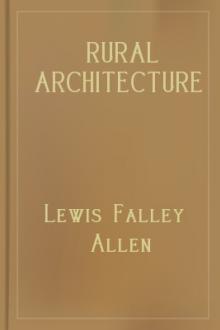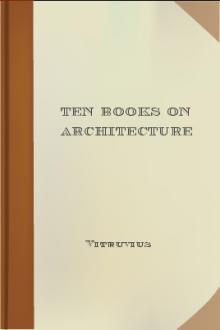Rural Architecture by Lewis Falley Allen (accelerated reader books .txt) 📖

- Author: Lewis Falley Allen
- Performer: -
Book online «Rural Architecture by Lewis Falley Allen (accelerated reader books .txt) 📖». Author Lewis Falley Allen
The site selected for the dwelling, and the character of the scenery and objects immediately surrounding it, should have a controlling influence upon the style in which the house is to be constructed. A fitness and harmony in all these is indispensable to both expression and effect. And in their determination, a single object should not control, but the entire picture, as completed, should be embraced in the view; and that style of building constituting the most agreeable whole, as filling the eye with the most grateful sensations, should be the one selected with which to fill up and complete the design.
HOME EMBELLISHMENTS.A discussion of the objects by way of embellishment, which may be required to give character and effect to a country residence, would embrace a range too wide, in all its parts, for a simply practical treatise like this; and general hints on the subject are all indeed, that will be required, as no specific rules or directions can be given which would be applicable, indiscriminately, to guide the builder in the execution of his work. A dwelling house, no matter what the style, standing alone, either on hill or plain, apart from other objects, would hardly be an attractive sight. As a mere representation of a particular style of architecture, or as a model of imitation, it might excite our admiration, but it would not be an object on which the eye and the imagination could repose with satisfaction. It would be incomplete unless accompanied by such associates as the eye is accustomed to embrace in the full gratification of the sensations to which that organ is the conductor. But assemble around that dwelling subordinate structures, trees, and shrubbery properly disposed, and it becomes an object of exceeding interest and pleasure in the contemplation. It is therefore, that the particular style or outward arrangement of the house is but a part of what should constitute the general effect, and such style is to be consulted only so far as it may in itself please the taste, and give benefit or utility in the purposes for which it is intended. Still, the architectural design should be in harmony with the features of the surrounding scenery, and is thus important in completing the effect sought, and which cannot be accomplished without it.
A farm with its buildings, or a simple country residence with the grounds which enclose it, or a cottage with its door-yard and garden, should be finished sections of the landscape of which it forms a part, or attractive points within it; and of consequence, complete each within itself, and not dependent upon distant accessories to support it—an imperium in imperio, in classic phrase. A tower, a monument, a steeple, or the indistinct outline of a distant town may form a striking feature in a pictorial design and the associations connected with them, or, the character in which they are contemplated may allow them to stand naked and unadorned by other objects, and still permit them to fill up in perfect harmony the picture. This idea will illustrate the importance of embellishment, not only in the substitution of trees as necessary appendages to a complete rural establishment, but in the erection of all the buildings necessary for occupation in any manner, in form and position, to give effect from any point of view in which the homestead may be seen. General appearance should not be confined to one quarter alone, but the house and its surroundings on every side should show completeness in design and harmony in execution; and although humble, and devoted to the meanest purposes, a portion of these erections may be, yet the character of utility or necessity which they maintain, gives them an air of dignity, if not of grace. Thus, a house and out-buildings flanked with orchards, or a wood, on which they apparently fall back for support, fills the eye at once with not only a beautiful group, in themselves combined, but associate the idea of repose, of comfort, and abundance—indispensable requisites to a perfect farm residence. They also seem to connect the house and out-buildings with the fields beyond, which are of necessity naked of trees, and gradually spread the view abroad over the farm until it mingles with, or is lost in the general landscape.
These remarks may seem too refined, and as out of place here, and trenching upon the subject of Landscape Gardening, which is not designed to be a part, or but an incidental one of the present work, yet they are important in connection with the subject under discussion. The proper disposition of trees and shrubbery around, or in the vicinity of buildings is far too little understood, although tree planting about our dwellings is a practice pretty general throughout our country. Nothing is more common than to see a man build a house, perhaps in most elaborate and expensive style, and then plant a row of trees close upon the front, which when grown will shut it almost entirely out of view; while he leaves the rear as bald and unprotected as if it were a barn or a horse-shed—as if in utter ignorance, as he probably is, that his house is more effectively set off by a flanking and background of tree and shrubbery, than in front. And this is called good taste! Let us examine it. Trees near a dwelling are desirable for shade; shelter they do not afford except in masses, which last is always better given to the house itself by a veranda. Immediately adjoining, or within touching distance of a house, trees create dampness, more or less litter, and frequently vermin. They injure the walls and roofs by their continual shade and dampness. They exclude the rays of the sun, and prevent a free circulation of air. Therefore, close to the house, trees are absolutely pernicious, to say nothing of excluding all its architectural effect from observation; when, if planted at proper distances, they compose its finest ornaments.
If it be necessary to build in good taste at all, it is quite as necessary that such good taste be kept in view throughout. A country dwelling should always be a conspicuous object in its full character and outline, from one or more prominent points of observation; consequently all plantations of tree or shrubbery in its immediate vicinity should be considered as aids to show off the house and its appendages, instead of becoming the principal objects of attraction in themselves. Their disposition should be such as to create a perfect and agreeable whole, when seen in connection with the house itself. They should also be so placed as to open the surrounding landscape to view in its most attractive features, from the various parts of the dwelling. Much in the effective disposition of trees around the dwelling will thus depend upon the character of the country seen from it, and which should control to a great extent their position. A single tree, of grand and stately dimensions, will frequently give greater effect than the most studied plantations. A ledge of rock, in the clefts of which wild vines may nestle, or around which a mass of shrubbery may cluster, will add a charm to the dwelling which an elaborate cultivation would fail to bestow; and the most negligent apparel of nature in a thousand ways may give a character which we might strive in vain to accomplish by our own invention. In the efforts to embellish our dwellings or grounds, the strong natural objects with which they are associated should be consulted, always keeping in view an expression of the chief character to which the whole is applied.
MATERIAL FOR FARM BUILDINGS.In a country like ours, containing within its soils and upon its surface such an abundance and variety of building material, the composition of our farm erections must depend in most cases upon the ability or the choice of the builder himself.
Stone is the most durable, in the long run the cheapest, and as a consequence, the best material which can be furnished for the walls of a dwelling. With other farm buildings circumstances may govern differently; still, in many sections of the United States, even stone cannot be obtained, except at an expense and inconvenience altogether forbidding its use. Yet it is a happy relief that where stone is difficult, or not at all to be obtained, the best of clay for bricks, is abundant; and in almost all parts of our country, even where building timber is scarce, its transportation is so comparatively light, and the facilities of removing it are so cheap, that wood is accessible to every one. Hence we may indulge in almost every fitting style of architecture and arrangement, to which either kind of these materials are best adapted. We shall slightly discuss them as applicable to our purposes.
Stone is found either on the surface, or in quarries under ground. On the surface they lie chiefly as bowlders of less or greater size, usually of hard and durable kinds. Large bowlders may be either blasted, or split with wedges into sufficiently available shapes to lay in walls with mortar; or if small, they may with a little extra labor, be fitted by the aid of good mortar into equally substantial wall as the larger masses. In quarries they are thrown out, either by blasting or splitting in layers, so as to form regular courses when laid up; and all their varieties may, unhammered, except to strike off projecting points or angles, be laid up with a sufficiently smooth face to give fine effect to a building. Thus, when easily obtained, aside from the greater advantages of their durability, stone is as cheap in the first instance as lumber, excepting in new districts of country where good building lumber is the chief article of production, and cheaper than brick in any event. Stone requires no paint. Its color is a natural, therefore an agreeable one, be it usually what it may, although some shades are more grateful to the eye than others; yet it is always in harmony with natural objects, and particularly so on the farm where everything ought to wear the most substantial appearance. The outer walls of a stone house should always be firred off inside for lathing and plastering, to keep them thoroughly dry. Without that, the rooms are liable to dampness, which would penetrate through the stone into the inside plastering unless cut off by an open space of air between.
Bricks, where stone is not found, supply its place tolerably well. When made of good clay, rightly tempered with sand, and well burned, they will in a wall remain for centuries, and as far as material is concerned, answer all purposes. Brick walls may be thinner than stone walls, but they equally require "firring off" for inside plastering, and in addition, they need the aid of paint quite as often as wood, to give them an agreeable color—bricks themselves not usually being in the category of desirable colors or shades.
Wood, when abundant and easily obtained, is worked with the greatest facility, and on many accounts, is the cheapest material, for the time, of which a building can be constructed. But it is perishable. It requires every few years a coat of paint, and is always associated with the idea of decay. Yet wood may be moulded into an infinite variety of form to please the eye, in the indulgence of any peculiar taste or fancy.
We cannot, in the consideration of material for house-building therefore, urge upon the farmer the adoption of either of the above named materials to the preference of another, in any particular





Comments (0)